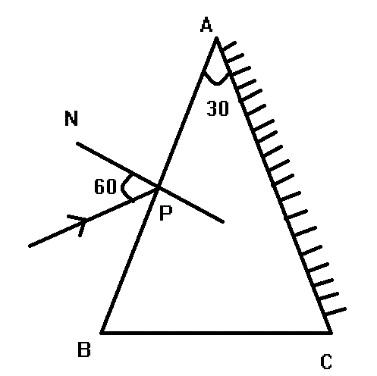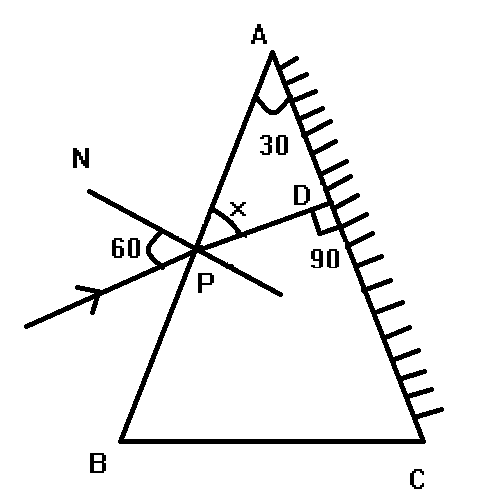Question
Question: An isosceles prism of angle \(A = {30^\circ }\) has one of its surfaces silvered. Light rays falling...
An isosceles prism of angle A=30∘ has one of its surfaces silvered. Light rays falling at an angle of incidence 60∘ on the other surface retrace their path after reflection from the silvered surface. The refractive index of prism material is

(A) 1.414
(B) 1.5
(C) 1.732
(D) 1.866
Solution
Hint Here in this question we start by using Snell’s law which describes the relationship between the angle of incidence and angle of refraction. By using this relation we will find the refractive index of the given prism by using the relationship between the angle of incidence and angle of refraction.
Formula used
⇒η1η2=sinϑrsinϑi
⇒∠PDC=∠DAC+∠APD
Complete Step by step solution

Here from the figure, we can observe that angle of incidence is given which is {60^^\circ } and also given that the angle of the prism is {30^^\circ } . Starting with Snell’s law which states that
⇒η1sinϑi=η2sinϑr
⇒η1η2=sinϑrsinϑi
Here, η1=1(for air the refractive index is 1 )
And η2 is the refractive index of the prism
Hence we get
⇒η2=sinϑrsinϑi -------- equation (1)
∴ϑi= 60∘(Angle of incidence) given so at first we have to find the angle of refraction ϑr .
Now from the diagram, we can see that in the triangle ΔAPD from the exterior angle property which states that the exterior angle of a triangle is equal to the sum of opposite interior angles of the triangle. So
⇒∠PDC=∠DAC+∠APD
∴∠APD=∠DAC−∠PDC
Substituting the values in the above equation,
⇒x=90∘−30∘
∴x=60∘
Now from the above value of x , we can obtain the angle of refraction ϑr
⇒ϑr=90∘−x
∴ϑr=90∘−60∘=30∘
Now putting the value of ϑr in the equation (1) we get the refractive index of the prism η2
⇒η2=sin30∘sin60∘
∴η2=3=1.732
Therefore the refractive index of prism material is η2=1.732 .
So the option (C) is the correct answer.
Note Here the above question is solved by following Snell’s law which is also known as the law of refraction which states the relationship between the angle of incidence, angle of refraction, and the absolute refractive index of the respective mediums.
